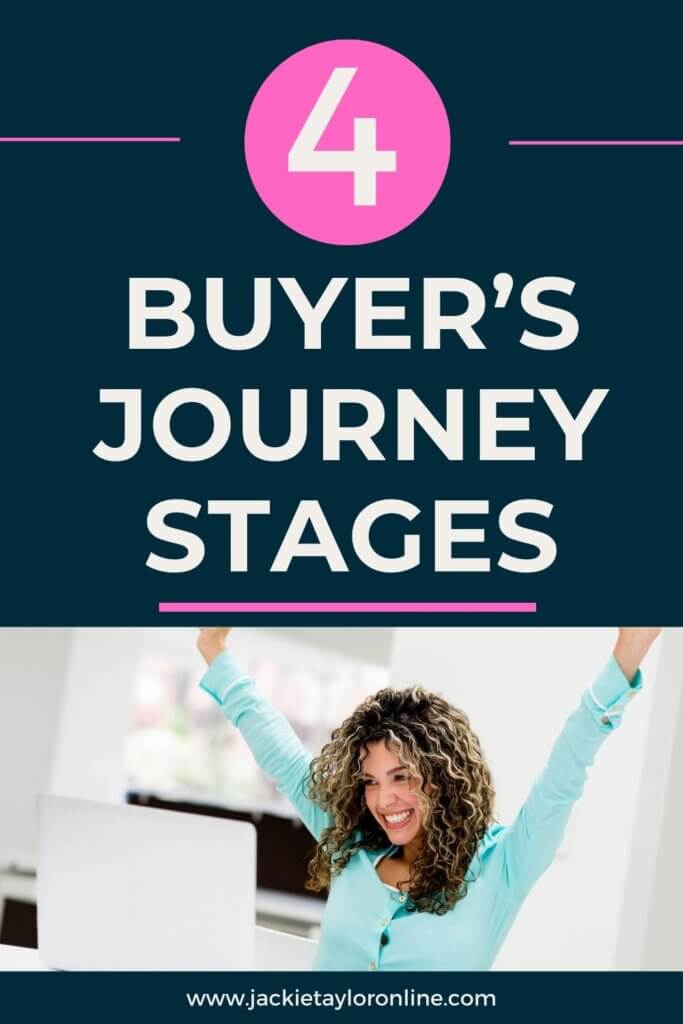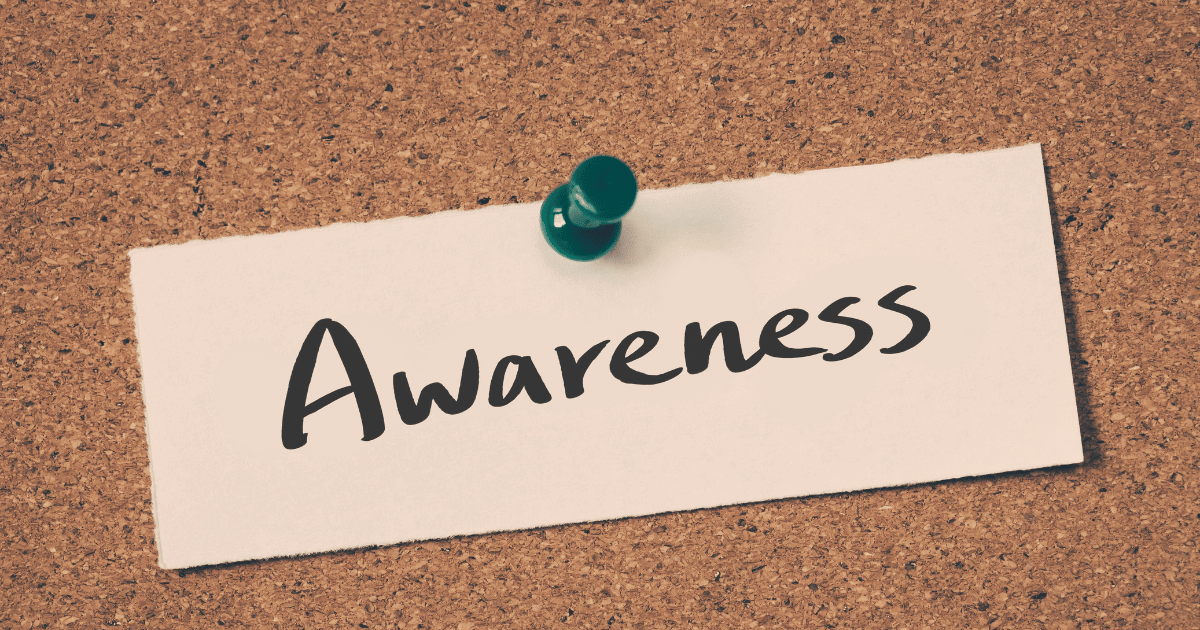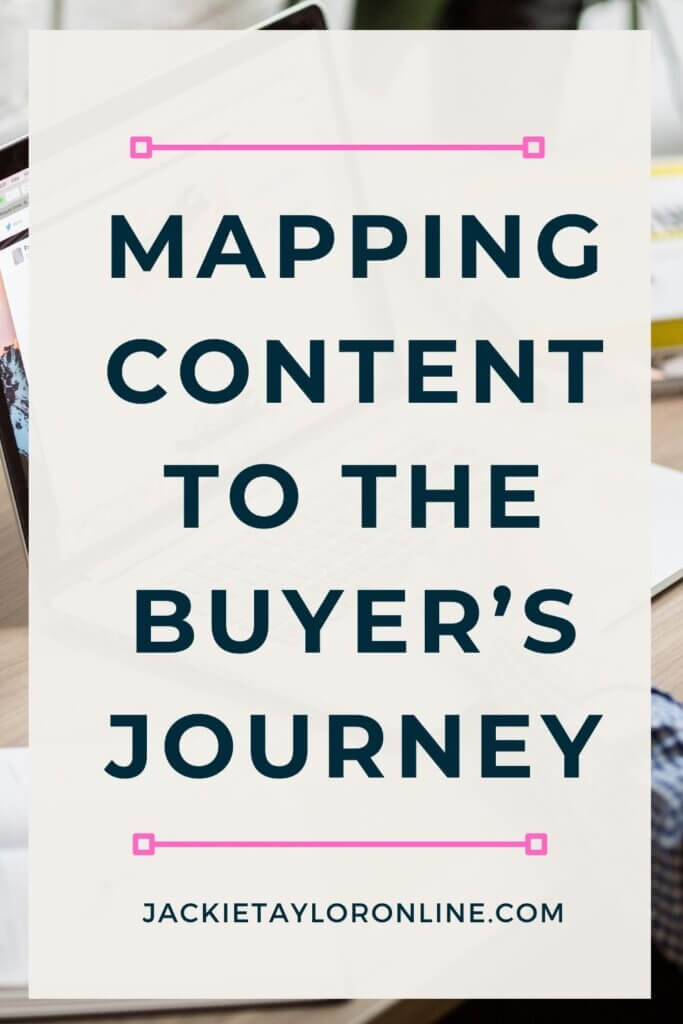Creating content that aligns with the buyers journey is essential for effectively promoting your online small business and guiding potential customers through the purchasing process. The buyers journey, also known as the customer journey, is the process that a consumer goes through when researching, evaluating, and making a purchase online. The stages of the buyers journey typically include awareness, consideration, and decision. But I add one more step that is the most important step for creating customer loyalty and raving fans. Let’s get to it.
AFFILIATE DISCLAIMER: I SOMETIMES LINK TO PRODUCTS AND SERVICES TO HELP COVER THE COSTS OF RUNNING THIS BLOG. THERE’S NO EXTRA COST TO YOU – AND I ONLY RECOMMEND PRODUCTS THAT I’VE BOTH USED PERSONALLY AND THINK ARE QUALITY PRODUCTS THAT HELP WITH EFFICIENCY. PLEASE READ MY AFFILIATE DISCLOSURE FOR MORE INFORMATION. THANKS FOR YOUR SUPPORT!

Table of Contents
What are the stages of the buyers journey?

1. Awareness Stage
During the awareness stage, your target audience is first becoming aware of a problem or need that they have.
The content that you create during this stage should focus on educating them about the problem or need.
And while doing so, you’ll make sure to position your product or service as the solution. This content should be informative and address your audience’s pain points.
Examples of content that you can create during this stage include:
- Blog posts (How to guides, listicles, checklists)
- How to videos (this may even introduce your audience to your product or service)
- Checklist PDF Guide
- Cheatsheets
- Ebooks
- Tools & Resource Guides
- Hint: Many of these options are great for freebies (lead magnets) to grow you email list at the same time
If you use no other type of content, make sure educational content is included in your content strategy.
Because sales come from understanding. If you can create content that helps your audience understand what you offer, and more specifically how it’ll help them, you’ll be on your way to increased sales. Aiming to help your audience will always be a great start to what type of content you need to create.

2. Consideration Stage
During the consideration stage, the consumer has identified a problem or need and is actively researching solutions.
The content that you create during this stage should focus on highlighting the features and benefits of your product or service, and differentiate it from your competitors.
This content should be persuasive and address the consumer’s unique needs. Examples of content that you can create during this stage include:
- Product demos and tutorials
- Free trials
- Case studies and customer success stories
- Comparison charts and feature lists
Comparison charts are great for showing your customers exactly what you’re offering and what all they’ll get when they make a purchase. Even better, offer a free trial. If you believe in your product or membership results, let your audience try it out risk free. They just might realize they can’t live without it.
A freebie with just a touch of your best information and your teaching style can also work to let potential customers know how you teach and what your style is like.

3. Decision Stage
During the decision stage, the consumer has evaluated their options and is ready to make a purchase.
The content that you create during this stage should focus on providing social proof, such as customer testimonials that help encouraging them to make a purchase.
This content should be compelling and address any objections your target audience might have. Examples of content that you can create during this stage include:
- Customer testimonials and reviews
- Coupons and discounts
- Money-back guarantees and return policies
- Urgency or scarcity (only if it’s true – don’t use fake urgency) for limited-space or limited-time offers
By giving your audience a money-back guarantee, you can alleviate fears of purchasing from you. It helps your know, like, trust factor with your audience.
And customer testimonials or reviews are always helpful when trying to bust through customer objections. According to Learning Hub, 95% of consumers read online reviews before visiting a business. If that doesn’t tell you how important reviews are, I don’t know what will.
Not sure how to get reviews? There are some options listed in number 4 on this list. Or you can checkout SurveySolutions. It’s a product of multiple surveys that you can purchase (already created for you).
It’s a simple solution to getting testimonials that actually highlight your product’s best features. Plus, you’ll get multiple other surveys to help guide your business strategy for what to create next, and how to make your current digital products better.
And lastly, urgency or scarcity are a solid way to persuade anyone who’s on the fence about whether or not to purchase. But don’t use fake scarcity. Keep it authentic. If you only have room for 10 people in your group coaching program, make sure you let your audience know that. But don’t say one-time offer or limited-time price if you’re always offering your product at that price point. Your audience will know if you’re lying, and you’ll definitely lose their trust.
4. Delivery and Customer Follow-Up
The last step is actually two parts, but they go hand-in-hand, so I like to combine them. It’s delivery of your product or service and the customer follow-up.
Often times both are left out of the buyer’s journey for both in-person and online purchases. But, they’re the most important step in the buying process to create customer loyalty, raving fans, and get those great testimonials that you can plaster on your website, sales, pages, and social media.
Make sure your customers or clients are happy with their final product. Don’t create junk that they hate or is hard to use. You won’t get return customers that way. Do you ever return to a business that you feel had subpar products and/or service? NO! You definitely don’t.
According to Business.com, returning customers spend 67% more than new customers. Make sure to take care of your customers even after the sale. You might just get a customer for life if you’re providing the best possible customer service.
So, create a great customer experience. And then be sure to get that social proof that you need to get those “easy-yes” sales that you’re craving.
But how do you create a great customer experience?
- Create a great product that’s easy to use on it’s own
- Offer videos walkthroughs (over the shoulder walkthroughs) to make everything easy to understand and use
- Don’t create products that are long, hard-to-follow, or take too long to complete (follow-through is everything)
- Make things easy to consume and complete
- Follow-up and ask if they need help
But how can you follow-up with your customers?
Well, the first way is to have an automated email sent to ensure they have everything they need with the product or service they purchased. Ask questions like:
- Are you finding the information you need?
- Did you download the guides to help walk you through the process?
- Offer a support email address for any questions or a way to submit a support ticket with you.
- Get a done-for-you Support Ticket Request inside of SurveySolutions
And definitely send an email with a link to leave a testimonial. I would also include this link right inside of any deliverables that your customers receive as part of their purchase.
Again, you can check out SurveySolutions.
But, I would also include a way for your customers to promote your products for you. You don’t just want to make affiliate income by promoting others products.
Promote your own as well by offering an incentive to your happy customers. Did you love this course, download, membership, etc.? If so, you can earn 30% commission when you share it with your audience.
If you’re looking for a great way to increase sales, your own affiliate program is a great way to do so. Learn more about how you can use Thrivecart to setup your own affiliate program.
Email Service Providers: My Recommendation
I recommend Kit (previously called ConvertKit – use my affiliate link and get your first month free or sign up for the free account) if you’re looking for a free-to-start email provider. Kit offers free email for up to 1,000 subscribers. They also offer many segmentation options and categories to separate your email list for better promotions based on your followers needs.
The other option would be Flodesk (use my affiliate link to save 50% for the first year). They don’t offer as many segmentation options or even as many add-ons that Kit offers. But they have some of the most beautiful email templates for you to use. The number of templates to choose from isn’t huge (yet), but they are extremely easy-to-use if you’re new to having an email list and sending newletters.
Content Matrix and the Buyers Journey
The buyer’s journey can also be a part of your content matrix when you’re creating your online marketing strategy. Below is an example of a content matrix that includes and online buyer’s journey.
| Content Type | Awareness | Consideration | Decision |
|---|---|---|---|
| Blog post | Industry trends, best practices, How to articles, listicles, etc. | Case studies and customer success stories, review posts | N/A |
| Infographic | Problem or need | Infographic with customer reviews | Infographic of case studies with data. |
| Video | Introduction of Product/Service | Product demos and tutorials | N/A |
| Case studies | N/A | Customer success stories | Customer success stories with numbers and data that highlight your main selling points. |
| Comparison charts | N/A | Feature lists, compare to competitors | N/A |
| Testimonials | N/A | Raving customer reviews | Customer reviews that highlight your main selling points (From Structured Testimonials inside SurveySolutions). |
| Support Ticket Request | Create better products and remove any roadblocks that customers find. |
Now this is just an example. You can use different types of content or content formats that’ll suit your specific business and your ideal audience. The important thing is to align the content type with the stage of the buyer’s journey. Because your audience’s pain points and needs will change at each stage of the process.
And this also means picking your content type based on the questions asked on Google or social media platforms.
Create content that your audience is asking for, but also decide which stage of the buying process they’re in. This way you can tailor the content to best fit their current buying stage and also answer their questions or bust through any buying roadblocks.
Mapping Content to the Buyers Journey
By tailoring your content to fit your audience’s needs, not only are you setting your business up to be in front of your audience and meet them right where they’re at when searching online. But you’re also creating the right type of content that’ll quickly and easily catch their attention and at the right time.
So you’re making it easier for them to find you by creating content that’ll show up when they’re searching for the results and solutions that you offer.
And what you’re also doing through this process is looking at search intent. You can find what a searcher’s intent is simply by doing a regular Google search to see what comes up.

Buyers Journey Stages
Creating content that aligns with the different buyer’s journey stages can be an effective way to promote your online small business and guide potential customers through the purchasing process.
By understanding the different stages of the buyer’s journey and creating content that targets each stage, you’ll educate your potential customers about your products.
And at the same time, you’ll build a connection with them. That connection comes from creating content that instantly resonates with your target audience. And over time you’ll gain their trust. Trust and understanding is what leads your audience to make a purchase.
Latest Posts

+ show Comments
- Hide Comments
add a comment